#inline 5-cylinder
Explore tagged Tumblr posts
Text
작지만 강하고 빠르다! - 컴팩트 퍼포먼스 세단 더 뉴 아우디 RS 3 국내 판매 시작해
아우디의 초고성능 소형차 RS 3 세단이 우리나라에 판매됩니다. A3 세단을 바탕으로 407마력 엔진과 사륜구동 시스템, 스포츠 주행에 맞춰
조율한 섀시 등을 갖춘 것이 특징입니다.
아우디 코리아는 컴팩트 세단 A3의 초고성능 RS 모델인 더 뉴 아우디 RS 3 (The new Audi RS 3, 이하 RS 3 세단)을 2023년 7월 27일부터 우리나라에 판매한다고 발표했습니다. 경주 스포츠를 뜻하는 독일어 렌 스포트(Renn Sport)의 머리글자인 RS는 아우디의 고성능 차 생산 및 관련 기술 담당 자회사인 아우디 스포트(Audi Sport GmbH)가 생산하는 고성능 모델 라인업의 이름입니다. RS 모델들은 일반 모델을 바탕으로 엔진과 섀시를 고성능으로 업그레이드하고 스포츠 주행에 어울리도록 실내외를 꾸민 것이 특징인데요. RS 3 세단은 현재 아우디가 내놓고 있는 RS 모델 가운�� 가장 작은 4도어 세단입니다. RS 3은 2세대 모델에 해치백인 스포트백 모델로 첫선을 보인…
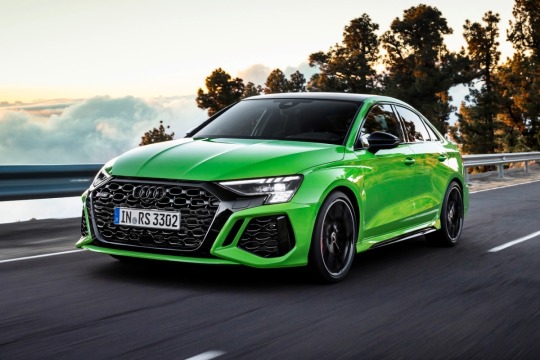
View On WordPress
#4-door#audi#audi rs#고성능 세단#inline 5-cylinder#세단#아우디#아우디 rs 3#직렬 5기통#콰트로#performance sedan#quattro#rs 3#rs 3 세단#rs 3 sedan
0 notes
Text



Daihatsu Charade DeTomaso 926R concept car from the 26th Tokyo Motor Show
An Optimum 1-Liter Midship-designed Car
Charade DETOMASO 926R
The ultimate in liter car driving. Equipped with a 926ccDOHC turbo engine mid-ship.
Charade DETOMASO 926R.
Charade DETOMASO 926R, a liter car Pioneer, pursues the ultimate in driving.
This is a 2BOX mid-engine model with the engine mounted in the rear seat, and a 50:50 front/rear weight balance for improved driving performance. This is a car that was completely tuned by the Italian company DeTomaso with the aim of making it a faster 2BOX car, rather than just a styling tune-up.
Of course, this is a first for a Japanese 2BOX car. The engine is based on the Charade 926 Turbo engine, which was produced in a limited number of 200 units last year with motorsports in mind, and is armed with a 4-valve DOHC.
The body is designed to enhance aerodynamic performance and cooling effects for the engine and suspension.
It is also equipped with top-notch Italian parts such as Pirelli's latest P700 and newly designed Campagnolo.
The Charade DETOMASO 926R is fully tuned by DeTomaso while retaining the basic Charade identity.
This machine is truly a little monster.
It is a Japanese-Italian hybrid prototype unique to Daihatsu.
Main specifications and equipment
●Total length 3,850×total width 1,640×total height 1,360mm
●Wheelbase 2,320mm
●Tread front 1,380 x rear 1,410mm
●Roading capacity: 2 people
●Engine: Water-cooled 4-stroke inline 3-cylinder DOHC (4 valves) with turbocharger
●Total displacement: 926cc
●Maximum output: 120PS (gross)
●Mission: 5 speed manual
●Brake: 4 wheel disc
●Suspension: Front strut type coil spring + stabilizer, rear strut type coil spring
●Tires: PIRELLI P700 (front 205/50VR15, rear 225/50VR15)
●Wheel: CAMPAGNOLO (magnesium alloy. Front 6J x 15, rear 7J x 15)
●Muffler: ANSA (dual exhaust)
●Steering: MOMO (350$ leather wrapped)
●Meter: VEGLIA (independent round type)
●Fog lamp: CARELLO
●Door mirror: VITALONI
●Horn: FIAMM (air horn)
44 notes
·
View notes
Text
I'm delighted that I got this new Matchbox Morgan Plus Four.

I adore Morgans; always have. While they are less than practical in most cases, they tick every other box for me. Let's explore what Morgans are and why I love them.

Morgan is a British company - which is still fully true to my knowledge, because in this ridiculous world we currently occupy, there are degrees to this sort of statement. MG was a British company, got acquired by a Chinese consortium and, with its cars built in China, is in no sense beyond the historical a British company; Land Rover still build its cars in the UK but it's owned by Tata of India. Are Land Rover still British? I'd say yes, but it's arguable. But Morgan is owned partly by the family of founder Henry Morgan (along with a private equity group, because you can't fucking escape the bullshit of 2025) and operate from Malvern in Worcestershire (pronounced "WOOstersheer"), as it has since 1909. This is crucial in understanding what Morgan is about; the company is a small-volume producer, because they still build all their cars by hand.


No robots, no mass-production. Every single one is bespoke, uniquely built to the customer's specifications, and as someone with an incessant urge to customise everything this is an extremely appealing attribute. It's hard to overstate how much I like the idea of a coachbuilt car made by craftspeople with decades of experience, but with modern technology and reliability. They have three models presently, the Plus Four, the Supersport and the Super 3 (recently made by Hot Wheels). Past models included the 4/4 with 4 seats, the +8 with a V8 and the Aero, which was an enclosed and streamlined model, along with a whole tine of 3-wheelers.

They are largely aluminium in construction, with a wooden subframe, which makes them very light. Of course, the look is iconic and dates back to around 1936, revised a little in 1950 and not much since, although it's often tweaked and given modernised tech. Morgan don't make their own engines, and the current range use BMW inline engines for the 4-wheelers (a 2-litre B48B20O1 turbo i4 making 255 hp for the Plus Four, and a 335hp B58B30C i6 with a twin-scroll turbo for the Supersport) and a Ford 3-cylinder for the 3-wheeler Super 3. Past models have used Ford, Mazda and Rover engines

They're all RWD, with auto or manual options that hit 60 in about 5 seconds in the Plus Four, and a sub 4-second 60 via auto only in the Supersport. What results is a sports car in the classic sense that Mazda was aiming for with the MX-5, not brutally powerful or transcendently fast but small, low, responsive, agile and focused on being fun to drive. They have only the space behind the seats for cargo, plus an optional rack on the back, and while third-party rigid hardtops exist there's no factory option, so they'd be pretty hard to live with as primary everyday cars, but as a car for enjoying driving, and as drivable art, I think there's probably none better.

Notably with this, it's basically exactly the same size as the 1:55 Siku +8, which is odd, as the little figures are supposed to be 1:75 scale but seem pretty well fitted to the car. The Super 3 is a bit larger scale, while the Majorette (the more battered green one, which has HW real riders but is very much not a HW model) is a touch longer. The inability of diecast makers to stick to a single scale drives me up the wall.
9 notes
·
View notes
Text
youtube
The Volvo 850 was launched in 1992 as a front-wheel-drive family car with a transversely mounted 2.0 to 2.5-liter inline-five engine. It featured a sophisticated multi-link rear suspension and a focus on safety and comfort. But beneath its practical image, the 850 had solid engineering — enough for Volvo to take it racing.
In 1994, Volvo entered the British Touring Car Championship with the 850 Estate — the first time a wagon had competed at this level. Developed in collaboration with Tom Walkinshaw Racing, or TWR, the BTCC-spec 850 was fully race-prepped.
It ran a naturally aspirated 2.0-liter inline-five engine producing around 280 horsepower at over 8,000 RPM, mated to a six-speed sequential gearbox. It featured front-wheel drive, a limited-slip differential, race-tuned suspension, and AP Racing brakes. The body was stripped and reinforced, weighing in at roughly 975 kilograms.
Aerodynamically, the estate shape wasn’t ideal. Its tall rear created more drag compared to the sedan. But the longer roofline added stability, and the car’s unique profile helped grab media attention.
The car was driven by Rickard Rydell, a Swedish touring car specialist, and Jan Lammers, a former Formula 1 and endurance driver. Despite its unconventional form, the 850 Estate showed competitive pace.
While it didn’t win races, it scored consistent mid-field results — including a best finish of fifth place at Snetterton. It laid the groundwork for future success. In 1995, Volvo switched to the 850 saloon, retaining the same mechanical setup but with better aerodynamics. That year, Rydell won two races and finished third overall in the championship standings.
The estate only ran for one season, but it left a lasting impression.
Volvo 850 Estate BTCC 1994 Technical Specifications
General Model Volvo 850 Estate Year 1994 Series British Touring Car Championship BTCC Team Volvo TWR Tom Walkinshaw Racing Drivers Rickard Rydell Jan Lammers
Engine Type Volvo B5204T based inline 5 Displacement 2 0 liters 1984 cc Configuration Naturally aspirated 5 cylinders Power Output Approximately 280 hp at 8500 rpm Torque Estimated 245 Nm Valvetrain DOHC 20 valves Engine Management Racing spec ECU developed by TWR
Transmission Type Xtrac 6 speed sequential gearbox Drivetrain Front wheel drive Differential Limited slip differential
Chassis and Body Chassis Modified production unibody Body Style 5 door estate station wagon Construction Seam welded reinforced for racing Weight Approx 975 kg per BTCC regulations Roll Cage FIA spec full roll cage Aerodynamics Front splitter minimal rear wing estate roofline provided natural rear stability
Suspension Front MacPherson struts with coil springs and adjustable dampers Rear Delta link rear axle with coil springs and adjustable dampers Setup Fully adjustable racing suspension
Brakes Front AP Racing ventilated discs with 4 piston calipers Rear AP Racing solid discs Brake Bias Adjustable
Wheels and Tires Wheels 18 inch center lock alloy race wheels Tires Dunlop racing slicks BTCC control tire
Interior and Safety Interior Stripped with single racing seat Harness Racing harness Fire System Onboard fire suppression system Dash Digital dash and data acquisition system
Performance Estimates Zero to sixty mph Around 4 point 5 seconds Top Speed Approximately 150 mph depending on gearing and track
Notable Results 1994 Best Finish 5th place at Snetterton Overall Points Consistent mid field performance Public Impact High media attention due to unconventional estate body style.
2 notes
·
View notes
Text
1968 began the onset of a slew of Neue Klasse” range of BMW’s after a 5 year hiatus and catapulted BMW out of near bankruptcy and it’s design dynamism with emphasis on performance plus luxury dominated Mercedes-Benz, it’s primary competitor back then.

Cue the arrival of something rather special, the likes of which this segment had never seen: a classy sedan boasting the performance, poise and assurance of a sports car. Its newly developed engine was to write a new chapter in BMW history with its variants from 2.5 liters to 3.3 liters.
2.8 L M30B28 Inline 6 cylinder.
Gearbox type: 3 Speed Automatic transmission
Power: (KW / HP):125 / 170
Displacement: (ccm):2788
Torque: 234lbs
Fuel system: Carburetor
(Fuel injection from 1971 onwards)
Acceleration: 10.5 seconds
Too Speed: 193km/ 120mph
#bmwlove#bmw#bmw motorsport#automotive#bmwlife#auto show#automobile#muscle car#auto news#bmw lovers#bmw classic#bmw cars#bmwmotorrad#bmwedit
5 notes
·
View notes
Text
2024 Honda CB650R
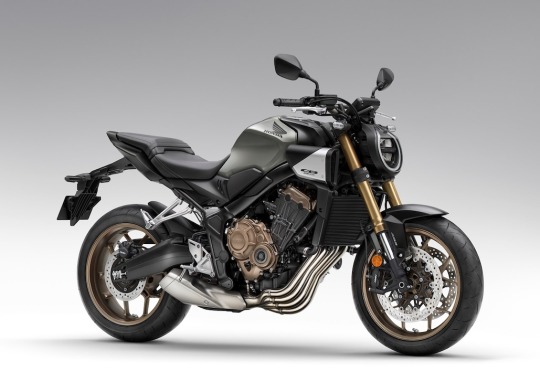

For 24YM Honda’s naked four-cylinder jewel evolves its Neo Sports Café style with a sharp styling update from nose to tail. A brand-new 5-inch TFT screen offers Honda RoadSync connectivity, operated by simplified new 4-way toggle switch. Engine performance is unchanged at 70kW power and 63Nm torque, with an A2 option. The CB650R - alongside the CBR650R super sports bike - will be the first Honda to be offered with the option of Honda E-Clutch technology, which gives the rider choice of automatic clutch operation by simply using the shift pedal. Chassis specification includes Showa SFF-BP USD forks, dual four-piston radial mount front calipers and 120/70-ZR17 and 180/55-ZR17 tyre combination. Two brand-new paint options and two new colour combinations strike a contemporary chord.
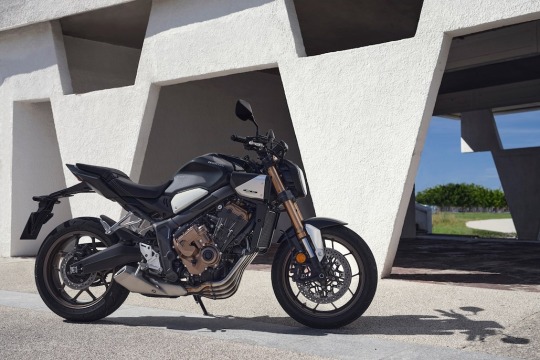
- Introduction Honda has always thrived on exploring new boundaries – in design as well as engineering. In 18YM, the CB1000R, CB300R and CB125R brought a fresh identity to its naked motorcycle line-up, mixing café racer inspirations with a forward-looking ultra-minimalist look under the ‘Neo Sports Café’ design theme. In 19YM the CB650R joined the family and its combination of cool styling, exhilarating four-cylinder engine performance and light, versatile handling ensured immediate sales success. Building on the momentum, for 21YM it received a major front suspension upgrade, plus a range of detail improvements to enhance comfort, usability and practicality. 24YM is an important year for the CB650R and while updated style and functionality will get attention, this bike – alongside its naked sibling, the CBR650R – will go down in history as the first Honda to be available with Honda E-Clutch technology, which is designed to make motorcycling, from beginner right through to expert, even more enjoyable – and even more exciting. Valerio Aiello, of Honda’s Rome R&D Department on the Neo Sports Café design aesthetic: “The entire current Neo Sport Café range from Honda is the result of the CB4 Concept model presented at EICMA in 2015. Our desire was to explore the world of the café racer and reinterpret it in a modern key. We wanted to create neo-classics – that is, modern motorcycles showcasing classic design styles combined with modern techniques. I used inspiration from outside the world of motorcycles, in watches. I’ve always liked their technicality and one of the key concepts used during the Neo Sports Café design was 'Mechanical Art'. This is the desire to show the beauty of the various mechanical elements to which Honda has always given great importance.”
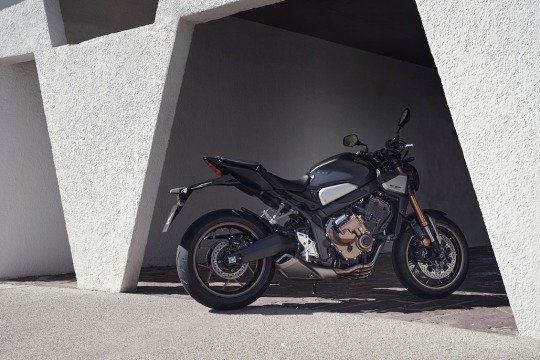
- Model Overview There’s a fresh look to the CB650R’s retro minimalism. A new headlight, radiator shrouds, rider/pillion seat, tail unit and taillight inject a more dynamic energy, while the fuel tank remains a strong presence above the beautiful inline four-cylinder engine. A new 5-inch full colour TFT screen is designed for readability on bright days and features Honda RoadSync connectivity. Managed by a new, easy-to-use 4-way lefthand backlit toggle switch the rider can now enjoy on-screen, turn-by-turn navigation in addition to other smartphone features. Performance is unchanged: 70kw peak power with 63Nm are fun figures for a naked bike, and the classic in-line 4 cylinder ‘pick-up’ and high-revving top end power are longstanding Honda calling cards. A 35kW option is available for A2 licence holders. Available as an option on the CB650R, the new Honda E-Clutch takes away the need for the rider to use the clutch lever to make a shift either up or down the gearbox. The chassis is as before and a perfect package from city block to twisting back road. A steel diamond frame provides core rigidity while 41mm Showa SFF-BP USD front forks and Showa rear shock deliver high-quality suspension control. Four-piston radial-mount front brake calipers work 310mm floating discs and cast aluminium wheels mount 120/70-ZR17 and 180/55-ZR17 front and rear tyres. The 24YM CB650R will be available in the following colour options: **NEW** Matt Laurel Green Metallic with Matt Vulcan Silver Metallic details **NEW** Pearl Smokey Gray, with Matt Crypton Silver Metallic details Candy Chromosphere Red with NEW Matt Crypton Silver Metallic details Matt Gunpowder Black Metallic with NEW Matt Crypton Silver Metallic details
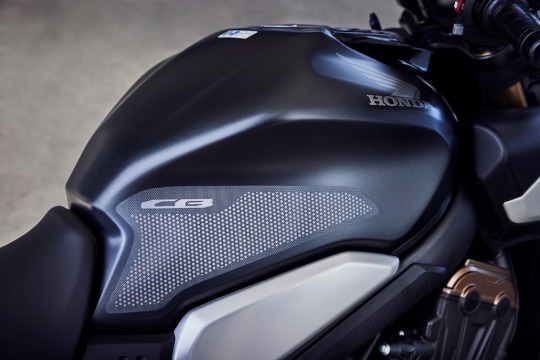
- Key Features 3.1 Styling & Equipment - Neo Sports Café styling evolves dynamically - New 5-inch full colour TFT screen includes Honda RoadSync connectivity for on-screen turn-by-turn navigation and access to other smartphone functions - New, simplified left hand switchgear easy to use and backlit for night-time - All lighting LED; new slanted headlight matched by new taillight design Tightly wrapped, the CB650R’s Neo Sports Café style evolution features the signature compact ‘Trapezoid’ proportion of a new, sharper tail and short-overhang and new slanted LED headlight All other lighting is LED, and a new taillight tucks seamlessly into the new fairing. From the front, via the new radiator shrouds backwards, the overall look is sinuous, more dynamic and with keen sense of purpose. The long fuel tank remains a key motif of the family design; its smooth lines accentuate the solidity of real metal surfaces and crown the engineering of the four-cylinder powerplant. It also houses the ignition. A 35° handlebar angle makes tight, slow-speed turns and U-turns straightforward. The shape of the pillion and rider seats have been revised to match the new tail; seat height remains 810mm. There’s a USB Type-C socket located under the seat. Premium technology – in the form of a brand new, 5-inch full colour TFT screen – uses optical bonding to improve visibility in bright sunlight. By sealing the gap between the cover glass and TFT screen with resin, glare is reduced, and visibility improved. The display itself is customisable between ‘Bar’, ‘Circle’ and ‘Simple’ display patterns and also, for the first time on the CB650R, offers the smartphone connectivity of Honda RoadSync. Honda RoadSync – alongside a new simplified, easy-to-use, backlit 4-way toggle-switch on the left handlebar – allows straightforward, on-screen turn-by-turn navigation as well as the option (via a Bluetooth helmet headset) for the rider to make calls, listen to music or receive voice feedback of weather conditions. All an owner has to do is download the free Honda RoadSync app from either the Play Store or the App Store, connect to the CB650R, and go.
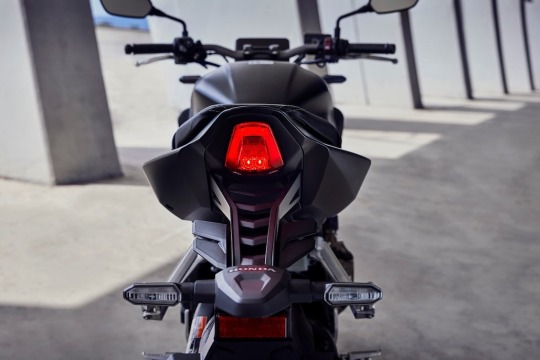
3.2 Chassis - 41mm Showa Separate Function Big Piston (SFF-BP) USD forks - Four-piston, radial-mount front brake calipers and floating discs - 120/70-ZR17 and 180/55-ZR17 front and rear tyres The steel diamond frame uses pressed swingarm pivot plates and twin elliptical spars with a rigidity balance specifically tuned (stiffer around the headstock and more flexible in the spar sections) to deliver excellent all-round handling characteristics with high levels of rider feedback. Rake is set at 25.5° with trail of 100mm and wheelbase of 1,450mm. Kerb weight is 205kg (207kg E-Clutch). Showa’s 41mm Separate Function Big Piston (SFF-BP) USD forks offer high-quality reaction. A pressure separation damper in one fork tube and spring mechanism in the other deliver high damping performance and lighter weight. Together with the use of a larger sized piston, the result is increased feel, bump absorption and control. Adjustable for 10-stage spring preload, the single-tube monoshock operates directly on the curvaceous gravity die-cast aluminium swingarm. Four-piston radial-mount front brake calipers work 310mm floating discs, and are paired with a single-piston rear caliper and 240mm disc. The ABS is a two-channel system. Cast aluminium wheels mount 120/70-ZR17 and 180/55-ZR17 front and rear tyres.

3.3 Engine - 70kW peak power with 63Nm peak torque - 35kW A2 licence option available - Honda Selectable Torque Control (HSTC) The 649cc, DOHC 16-valve engine is unchanged for 24YM. It’s tuned to create the purest, most enjoyable mid-sized four-cylinder performance possible, with the classically fast ‘pick-up’ through the rev range and hard-hitting, high-revving top end for which Honda’s in-line fours are renowned. Peak power of 70kW arrives @ 12,000rpm with peak torque @ 63Nm delivered at 9,500 rpm. A 35kW option is available for A2 licence holders. Direct cam actuation makes for a compact cylinder head; bore and stroke is set at 67mm x 46mm with compression ratio raised of 11.6:1. Iridium spark plugs are employed and twin air ducts – either side of the fuel tank – feed the airbox and produce a throaty intake roar. Asymmetric piston skirts minimise bore contact and reduce friction. Ferrous spines on the outer surface of the cylinder sleeves reduce oil consumption (and friction) with improved heat transfer and a silent SV cam chain reduces frictional losses by using a Vanadium coating on its pins. Internal water channelling from cylinder head to cylinders does away with most of the exterior hoses. The engine uses a compact internal architecture, stacked six-speed gearbox and starter layout with the cylinders canted forward 30°. An assist/slipper clutch eases upshifts while managing rear-wheel lock up under hard braking and rapid downshifts. Honda Selectable Torque Control (HSTC) manages rear wheel traction; it can be turned off should the rider choose. Fuel consumption of 20.4km/l (WMTC mode) gives a range of over 300km from the 15.4L fuel tank. EURO5 compliant, environmental efficiency has been updated with revisions to the ECU and catalyser, as well as the addition of an OBD2-2 sensor.
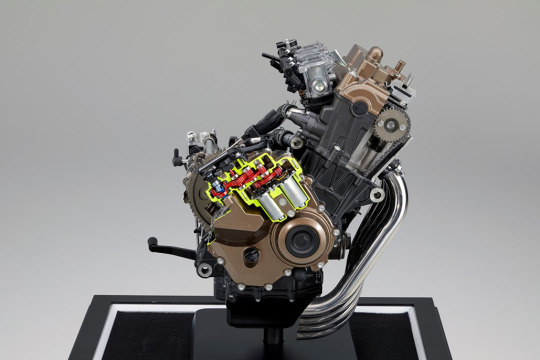
- Honda E-Clutch - see separate post - World-first technology allows the rider to start, stop and change gear without using the clutch lever – just the shift pedal - Available as an option from new; system adds 2kg to kerb weight - Honda E-Clutch also allows normal operation of the clutch lever - Brings more enjoyment and flexibility across a wide range of scenarios, for a ‘next level’ riding experience Honda E-Clutch takes elements of the technology and performance of quickshifters, manually-operated clutches and Honda’s Dual Clutch Transmission technology to create a unique blend of these well-proven approaches, opening up a whole new aspect of the motorcycling experience for riders of every type and experience level. The clutch and transmission hardware themselves are no different from a conventional motorcycle, with the ultra-compact system weighing only 2 kilograms. In operation, Honda E-clutch is simplicity itself, taking away the need to use the clutch lever to make a shift either up or down the gearbox. The rider simply has to operate the shift pedal for ultra-fast, consistent gear changes, bringing extra enjoyment to sporty riding. The clutch lever is also not needed when pulling away or coming to a stop. Becoming active as soon as the engine is switched on, the system manages both scenarios smoothly, while taking away the possibility of the engine stalling when in operation, providing extra convenience and peace of mind to town riding involving frequent starts and stops.

In addition to enjoyment and convenience, Honda E-Clutch brings ultimate flexibility. Should the rider wish, they are able to operate the clutch lever as normal at any time. When the clutch lever is used, the Honda E-clutch system will re-activate after less than a second above a certain engine rpm; after 5 seconds at lower engine speeds. Should the rider wish to turn off the system for a particular ride, this is also possible via the switchgear on the left handlebar. The change to manual operation is indicated by a letter ‘M’ on the instrument panel. The Honda E-Clutch also allows the rider to select an ‘operation feel’ to set the strength of the force required on the shift pedal to make a gear change. Three settings are available: HARD, MEDIUM, and SOFT, each of which can be chosen independently for upshifting and downshifting. The technology will also advise the rider to shift down - via a symbol on the instrument panel - if it detects the motorcycle is in a high gear at a certain speed. The Honda E-Clutch manages clutch engagement and disengagement based on its reading of parameters including vehicle speed, throttle opening angle, engine rpm, pressure on the shift pedal, clutch motor reduction gear angle, engine countershaft speed and gear position. The clutch is operated through an actuator unit with two motors situated inside the right hand engine cover. As the clutch is engaged or disengaged, the engine’s ignition timing and fuel injection are also controlled, resulting in smooth, shock-free shifting in any situation. Junya Ono, Large Project Leader, Honda E-Clutch: “Our Honda E-Clutch is designed to offer motorcyclists a new kind of experience that can make their riding even more fun and exciting. It also adds peace of mind and comfort to town riding or the daily commute. We hope that many riders will try our new system to enjoy the unique mix of sportiness and flexibility it offers.”
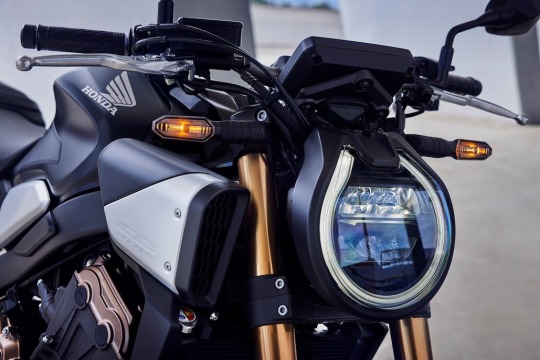
- Accessories A range of Genuine Honda Accessories are available for the CB650R, both available as individual items and grouped in packs, and are ready to bolt straight on: Style Pack Designed to complement the looks and style of the CB650R by adding high-quality aluminium inserts, Front Fender Panels, Radiator Shroud Covers, Side Cover Panels and Tank Side Stickers for added grip and protection. A red adonised Oil Level Gauge featuring the Honda logo adds a touch of colour and contrast. Sport Pack Pumps up dynamism with a Quickshifter (for non E-Clutch model), instrument Flyscreen for added wind protection, a Pillion Seat Cover featuring a dedicated aluminium plate, an Under Cowl that enhances the sporty appearance and finally, a Tank Pad that adds practical protection. Comfort Pack Cold weather rideability is improved with the addition of 5 stage Heated Grips with a memory function, plus the flexible, easy-to-attach carrying capacity of a Tank Bag with a see-through pocket for smartphones and an expandable 17L Rear Seat Bag that can be increased to 22L. The line-up is completed with Wheel Stripes available in different colours. All the accessories featured in packs can also be purchased individually. - Technical Specifications ENGINE Type Liquid-cooled 4-stroke 16-valve DOHC inline-4 cylinder Engine Displacement (cm³) 649cc Bore ´ Stroke (mm) 67.0 x 46.0 Compression Ratio 11.6:1 Max. Power Output 70kW/12,000rpm Max. Torque 63Nm/9,500rpm Oil Capacity 2.7L Noise Level (dB) Lwot – 78.8, Lurban – 74.2 FUEL SYSTEM Carburation PGM-FI electronic fuel injection Fuel Tank Capacity 15.4L Fuel Consumption 20.4km/litre ELECTRICAL SYSTEM Starter Electric Battery Capacity 12V/8.6AH ACG Output 380W DRIVETRAIN Clutch Type Wet, multiplate disc Transmission Type 6-speed Final Drive Chain FRAME Type Steel diamond CHASSIS Dimensions (LxWxH) 2130 x 780 x 1075mm Wheelbase 1450mm Caster Angle 25.5° Trail 100mm Seat Height 810mm Ground Clearance 150mm Kerb Weight 205kg 207kg E-Clutch Turning radius 2.8m SUSPENSION Type Front 41mm Showa Separate Function front Fork Big Piston (SFF-BP) USD forks Type Rear Monoshock damper with 10 stage adjustable preload, 43.5mm stroke WHEELS Rim Size Front Hollow section 6-spoke cast aluminium Rim Size Rear Hollow section 6-spoke cast aluminium Tyres Front 120/70ZR17 M/C (58W) Tyres Rear 180/55ZR17 M/C (73W) BRAKES ABS System Type 2 channel; hydraulic dual disc 310mm front, hydraulic disc 240mm rear INSTRUMENTS & ELECTRICS Instruments Digital speedometer, digital bar graph tachometer, dual trip meter, digital bar graph fuel gauge, gear position and upshift indicator, digital clock Headlight LED Taillight LED # Please note that the figures provided are results obtained by Honda under standardised testing conditions prescribed by WMTC. Tests are conducted on a rolling road using a standard version of the vehicle with only one rider and no additional optional equipment. Actual fuel consumption may vary depending on how you ride, how you maintain your vehicle, weather, road conditions, tire pressure, installation of accessories, cargo, rider and passenger weight, and other factors. Read the full article
6 notes
·
View notes
Text

Maserati Grassetto Shooting Brake 5-door
What if...Maserati took a bold approach and created this quick 5-door hatchback? First of it's kind from the manufacturer, this would be a practical touring car with optimal space and sleek styling. Equipped with a turbo inline 4 cylinder motor and all wheel drive paired with an automatic or manual transmission it would be a nice weekend getaway car.
6 notes
·
View notes
Text
Paranormal (Data Dump) 3A
One night in the fall of 2015 I was seeing those long skinny lights again at the boardwalk near the flag pole. I saw something I have never seen or heard of before. They were bird size, cough drop shape objects. They were intense royal blue light centers with dark blue edges. There were 5 of them and were following an inline pattern. It was odd to see them do a 360 helix like a rollercoaster. Then they did some “s” curves and flew over the beach to the south east over the ocean. Where were they headed? Where were they going to? My mind raced. I continued my walk. I reached a dead end of the boardwalk near a condo with a swimming pool next to the park. I saw one more, white light streak. I kept going back and almost every night I would see these three foot long, penny diameter cylinders of light until the end of December 2015. I have not seen them since 2015.
* In September and November of 2015 I saw stoplight green fireballs. The first one was in a nearby gated community, walking distance away. The other one was during Veterans Day week. Imagine a flare with a long fiery tail with the intensity of the go signal on a stoplight. This community didn’t have many houses in it yet. It was mostly empty lots at the time. It was nighttime and I was walking around. I came up to a corner and there I saw coming in the sky parallel to the road was this green fireball. It was odd to me because on this road there were only a few houses and the fireball came over from an area with no houses. The one in November I saw in the community I lived in. The exact same fire ball, but this time it flew diagonal to the road.
I also want to report that I saw the falling star phenomena again in the same week of Veterans Day. The white light twinkled, rotated clockwise, and dropped vertically.
* It was the night after Christmas. Nothing was stirring, except for me and a UFO. I was on my walk at the boardwalk enjoying the night air. I remember it was a little breezy on this night. The sound of ocean swells sounded like thunder and the waves slammed against the seashore. It was a fireball, red and orange in color coming from the southwest heading northeast. I would say it was about 4 times the size of the green fireballs I had seen. It was flying about the same height as the green fireballs would at about 40-50 feet above. I saw it clearly. It was a sphere with red and yellow flames with a white core and had a grayish smoke tail behind it. It flew over the nearby lagoon. The light was intense enough to add extra light to the park. Then it changed trajectory and headed northwest. I was astonished when it changed course completely!
* In my parent’s house during the day, I was just walking in the living room. I saw a seven foot tall ghost man wearing a silver suit; silver shoes, a silver top hat, and a white button down shirt. The man looked like he was in his 70’s and I could clearly see the wrinkles on his face. He had bushy eyebrows and a mustache. His hair and facial hair were blond. His chin looked freshly shaved. His eyes were hazel. The whole time I saw this ghost, he was see-through. I waved at the ghost. The ghost waved back to me and then vanished into a cloud of white smoke that drifted and disappeared into the nearby wall. I thought it was really cool.
#news#karate#paranormal#supernatural#spirituality#cryptid#ghost#ufo#spirit#ghosts#spirits#cryptids#artists on tumblr#real paranormal experiences#april#spring#school#driving
2 notes
·
View notes
Text
Best Classic Cars Under $15K: Timeless Icons on a Budget
Classic cars don’t have to break the bank. There are vintage legends with timeless designs, robust engineering, and undeniable charm that are still accessible for enthusiasts on a budget.
With a $15,000 price cap, the dream of owning a piece of automotive history is well within reach. We’ve curated a list of the best classic cars under $15K that combine style, performance, and collector appeal — all while respecting your wallet.
🔧 1. 1965–1973 Ford Mustang — The Affordable American Icon
The Ford Mustang is a cultural symbol that changed the game when it launched in 1964. The early first-generation Mustangs (especially the 1965–1968 models) are highly sought after and, surprisingly, still obtainable under $15K.
Why It Stands Out:
Classic pony car silhouette
Broad aftermarket support
Plenty of options: fastback, coupe, and convertible
Engine choices from the economical inline-six to the feisty V8
What to Expect for $15K: Well-maintained six-cylinder coupes or driver-condition small-block V8s with decent interiors and minimal rust.
🔥 2. 1981–1987 Chevrolet El Camino — Utility Meets Muscle
The El Camino blurs the line between muscle car and utility vehicle, giving you rear-wheel-drive thrills with pickup practicality.
Highlights:
V8 engines available
Retro styling with usable cargo bed
Strong community and parts availability
Distinctive street presence
For $15K: Look for clean, later models with the 5.0L or 5.7L V8 and upgraded suspension or cosmetic improvements.
🏁 3. 1978–1987 Chevrolet Monte Carlo — NASCAR DNA for the Street
If you’re seeking a luxurious two-door coupe with a muscle car heart, the Monte Carlo delivers. This G-body legend was born for cruising and easily customizable.
Why It’s Worth It:
Smooth ride and V8 power
Affordable parts
Stylish T-top options
Proven platform with collector upside
What $15K Buys You: SS models in running condition or non-SS in excellent shape. Look for minimal rust and a strong drivetrain.
💨 1984–1992 Chevrolet Camaro — Budget Muscle With Edge
The third-gen Camaro brought angular style and performance updates that made it a serious street contender.
Key Features:
Iconic IROC-Z styling
305 and 350 V8 options
Strong aftermarket
Lightweight RWD platform
Under $15K: Well-kept IROC-Z or Z28 trims are achievable. Choose lower-mileage examples with clean Carfax and limited rust.
🇩🇪 1970s–1980s Mercedes-Benz 450SL — Affordable European Elegance
The Mercedes-Benz 450SL (R107) offers a taste of German engineering and luxury with timeless looks. These convertibles offer solid performance and an upscale vibe.
Why It Impresses:
Reliable V8
Bulletproof build quality
Classy design with removable hardtop
Comfortable cruiser for weekend drives
For $15K: You’ll find good condition examples with functional interiors and service records. Check for timing chain and rust issues.
🇯🇵 1989–1997 Mazda MX-5 Miata — The Purest Driver’s Classic
The NA Miata is the embodiment of “Jinba Ittai” (horse and rider as one). Lightweight, rear-wheel drive, and immensely fun to drive, it’s a modern classic.
Why It Dominates:
50:50 weight distribution
Rev-happy engine
Simple mechanics and tuning ease
Strong enthusiast community
Under $15K Market: Expect mint early ’90s examples with clean bodies and tasteful mods. Avoid rust buckets from humid climates.
🚙 1970–1980 International Harvester Scout II — Vintage Off-Road Legend
Before the SUV boom, the Scout II defined ruggedness. It’s a boxy, go-anywhere machine that now enjoys cult classic status.
Why It’s Special:
Off-road capability
Bold vintage styling
Increasing collector demand
Great visibility and stance
For $15K: Find usable condition daily drivers with moderate upgrades. Watch for frame rust and body panel repairs.
1960s–1970s Volkswagen Beetle — Charming, Cheap, and Cult-Worthy
With over 21 million units sold, the Beetle is one of the most beloved classics ever made. It’s quirky, simple, and full of personality.
Top Traits:
Air-cooled simplicity
Endless parts availability
Huge enthusiast base
Iconic design
Under $15K: Restored or lightly modified versions from the 60s or 70s. Check engine seals, floor pan rust, and electrical condition.
💼 1980s Volvo 240 — Boxy Brilliance That Won’t Quit
The Volvo 240 blends Scandinavian restraint with legendary durability. It’s a slow-and-steady daily classic built like a tank.
Why Enthusiasts Love It:
Bulletproof 2.3L engine
RWD platform for modding
Easy maintenance
Sleeper classic potential
What You Get for $15K: Mint sedans or wagons with under 150k miles and original interiors. Look for models with manual transmissions and documented upkeep.
🕶 1980s Porsche 944 — Affordable Porsche Performance
A hidden gem from Stuttgart, the 944 delivers great handling and German driving purity at an approachable price point.
Why It’s a Smart Buy:
50:50 weight distribution
Affordable compared to 911
Striking wedge design
Excellent cornering and braking
For $15K: Clean base or 944S models. Turbo versions might stretch budget, but base trims offer plenty of performance. Service history is key.
🛻 Honorable Mentions
Jeep CJ-7 (1976–1986): Open-top 4x4 with legendary off-road prowess
BMW E30 (1982–1994): Sporty compact luxury with rising collector value
Datsun 280Z (1975–1978): Japanese muscle with smooth lines and straight-six reliability
📌 Tips for Buying Classic Cars Under $15K
1. Prioritize Mechanical Health Over Cosmetics: A solid drivetrain saves you more than new paint.
2. Check for Rust: Especially in older American and European models — underside, wheel wells, and door sills.
3. Join Online Forums and Groups: You’ll learn what to look out for, get parts faster, and access real-world maintenance tips.
4. Think of Future Appreciation: Some classics are increasing in value. Buy smart, and your $15K could become an appreciating asset.
5. Get a Pre-Purchase Inspection (PPI): Avoid surprises by letting a trusted mechanic evaluate the car before buying.
🚗 Final Thoughts: Classic Dreams Within Reach
Owning a classic car under $15K isn’t just a fantasy — it’s a smart investment in automotive history, passion, and weekend joyrides. Whether you’re drawn to American muscle, European refinement, or quirky charm, there’s a vintage ride waiting to be loved, restored, and proudly driven.
0 notes
Text
5 Luxury Sedans You Can Own Today from Our Second-Hand Car Collection
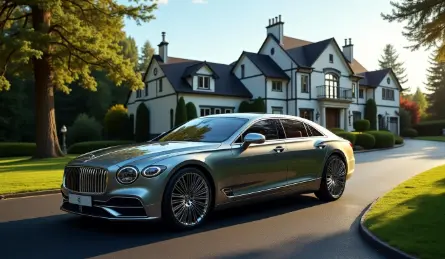
5 Luxury Sedans You Can Own Today from Our Second-Hand Car CollectionHave you ever dreamed of owning a luxury sedan but hesitated because of the hefty price tag? What if you could drive home a high-end car without breaking the bank? Pre-owned luxury sedans make that dream possible, offering the same elegance, comfort, and performance at a fraction of the cost.At our second-hand car collection, we have carefully selected some of the finest luxury sedans that balance style, technology, and reliability.
1. Mercedes-Benz E-Class –
Where Comfort Meets PowerWhen you think of a luxury sedan, Mercedes-Benz is one of the first names that comes to mind.
What Makes It Special?
Luxurious Cabin: Sink into plush leather seats, enjoy ambient lighting, and let the panoramic sunroof add a touch of elegance.
Tech-Savvy Ride: The MBUX infotainment system, touch-sensitive controls, and a state-of-the-art driver assistance system make driving effortless.
2. BMW 5 Series – The Ultimate Driving MachineDo you love the thrill of driving? The BMW 5 Series is designed to deliver an exciting ride while keeping you wrapped in luxury.
What You’ll Love:
Powerful Turbocharged Engines: Whether it’s a four-cylinder or an inline-six, expect quick acceleration and smooth performance.
Precision Handling: The 5 Series is known for its sharp steering and road grip, making every drive engaging.
3. Audi A6 – A Masterpiece of Style and InnovationIf you want a car that turns heads while offering cutting-edge technology, the Audi A6 is a top contender.
to know more, visit... https://themotorpedia.com/blog/5-luxury-sedans-you-can-own-today-from-our-second-hand-car-collection/268809dc8c30438212c95183e6577014
0 notes
Text
#푸조308 스텔란티스코리아가 푸조 308에 가솔린 마일드 하이브리드 시스템을 얹은 308 스마트 하이브리드를 출시했습니다. 1.2L 가솔린 터보 엔진과 변속기 일체형 48V 전기 모터를 결합하고 전기 모터 주행 범위를 넓혀 엔진 작동 시간을 줄인 것이 특징입니다.
#5-door hatchback#5도어 해치백#electrification#마일드 하이브리드#hatchback#inline 3-cylinder#스텔란티스코리아#푸조#해치백#전동화#직렬 3기통#mhev#mild hybrid#peugeot#stellantis korea
0 notes
Text
Yamaha 150hp 4-Stroke Outboard

When it comes to reliability, performance, and fuel efficiency, few outboard motors can compete with the Yamaha 150hp 4-stroke outboard. This engine is one of the most popular choices among recreational boaters, anglers, and even commercial users. It sits in the sweet spot of power—strong enough to push a range of boats efficiently, yet lightweight and manageable compared to heavier alternatives. In this article, we’ll dive deep into what makes the Yamaha 150hp 4-stroke outboard a standout in the marine engine market.
A Legacy of Dependability
Yamaha has a long-standing reputation for producing some of the most dependable outboard motors in the world. The Yamaha 150hp 4-stroke has earned the trust of thousands of boaters for its durability and consistent performance. Whether you're navigating saltwater, freshwater, or operating in tough weather conditions, this engine is built to last.
The 150hp model is part of Yamaha’s mid-range 4-stroke lineup, and it has become a flagship motor in this category. Known for its bulletproof reliability, the engine has been widely adopted by serious anglers, guides, and marine professionals who demand performance without compromise.
Key Features of the Yamaha 150hp 4-Stroke Outboard
1. Inline 4-Cylinder, DOHC Design
The Yamaha 150hp 4-stroke outboard is powered by a 2.7-liter inline 4-cylinder engine with Double Overhead Camshafts (DOHC). This design promotes smooth operation and high-end performance. The balance between power and efficiency is what makes this engine stand out. It can power everything from center consoles to pontoons, bay boats, and aluminum fishing vessels.
2. Fuel Efficiency
One of the biggest selling points of this outboard is its exceptional fuel economy. Thanks to Yamaha’s advanced fuel injection system, the engine uses less fuel than comparable 2-stroke motors while delivering cleaner emissions. For those who spend long days on the water, this translates to significant cost savings and fewer refueling stops.
3. Lightweight and Versatile
Despite its powerful output, the Yamaha 150hp 4-stroke is relatively lightweight, weighing around 478 pounds (dry weight). This makes it an excellent upgrade from older 2-stroke motors without dramatically affecting a boat’s weight balance. Its versatile design allows it to be used on a wide range of boat types.
4. Smooth and Quiet Operation
Noise and vibration are minimized, thanks to Yamaha’s focus on advanced mounting systems and sound-dampening engineering. The result is an engine that runs smoothly and quietly, enhancing the overall boating experience.
5. Corrosion Resistance
Yamaha employs a multi-layered anti-corrosion system that includes a patented alloy and protective paint coatings. This is particularly important for saltwater boaters, as it extends the engine’s lifespan even in harsh marine environments.
6. Variable Trolling RPM Control
Perfect for anglers, this feature allows you to adjust the trolling speed in 50 RPM increments. Whether you’re slow trolling for gamefish or maintaining a steady pace in calm waters, this gives you complete control.
7. Optional Digital Controls
The Yamaha 150hp 4-stroke is compatible with digital electronic controls (DEC), offering precision and responsiveness. If you're upgrading from a mechanical setup, this is a significant performance boost.
Performance Overview
The Yamaha 150hp 4-stroke delivers strong mid-range torque and excellent top-end speed. It accelerates quickly, planes fast, and maintains a comfortable cruise RPM with minimal vibration. Most users report speeds of 40–50 mph, depending on the boat hull and load. It is particularly efficient at cruising speeds, often burning only 5–6 gallons per hour, making it ideal for long-distance travel and fishing trips.
Maintenance and Ownership Costs
Routine maintenance on the Yamaha 150hp 4-stroke is relatively simple. Yamaha offers a detailed service schedule and access to a wide network of certified dealers and technicians. Oil changes, water pump inspections, and spark plug replacements are all straightforward, and the cost of ownership is lower than many competitors thanks to the engine’s reliability and efficiency.
Spare parts are widely available, and Yamaha’s support infrastructure is top-notch. The brand also offers extended warranties for added peace of mind.
Ideal Boat Types for the Yamaha 150hp 4-Stroke
The 150hp 4-stroke engine is incredibly versatile. It’s an excellent match for:
Center Consoles (18–22 ft)
Bay Boats
Dual Consoles
Bass Boats
Aluminum Fishing Boats
Pontoon Boats
RIBs and Inflatables
Whether you're a weekend warrior or a full-time guide, the Yamaha 150hp offers enough power to get you where you’re going—fast and efficiently.
Yamaha 150hp vs. the Competition
Compared to similar outboards from brands like Mercury, Suzuki, and Honda, the Yamaha 150hp 4-stroke consistently ranks among the top for fuel efficiency, reliability, and resale value.
Mercury 150 FourStroke: Slightly lighter and offers strong performance, but some users report more maintenance issues over time.
Suzuki DF150: Also a solid competitor with good efficiency, but Yamaha tends to have better dealer support and corrosion resistance.
Honda BF150: Known for smoothness and low emissions, but often heavier and more expensive.
Overall, Yamaha’s blend of performance, support, and reputation often makes it the preferred choice in this category.
Conclusion: Is the Yamaha 150hp 4-Stroke Worth It?
If you’re in the market for a dependable, high-performing, and fuel-efficient outboard motor, the Yamaha 150hp 4-stroke outboard is hard to beat. Its proven track record, wide compatibility with many boat types, and low cost of ownership make it a favorite among seasoned boaters and newcomers alike.
Whether you're chasing fish offshore, exploring backwater bays, or simply enjoying a day on the water with family, the Yamaha 150hp delivers performance you can trust. With proper maintenance, this engine can serve reliably for thousands of hours—making it one of the best investments you can make for your boat.
0 notes
Text





Honda Civic brochure pages.
CIVIC
The Super Civic was a new trend car with economy and dynamic performance suited to the 1980s.
1300 S
1500 SC
It perfectly combines the best fuel economy in the 1500cc class with powerful driving performance.
Resource and energy conservation are common themes around the world. The new CIVIC is available with a new engine system that takes advantage of the excellent combustion efficiency of the lean burn method, which is the greatest advantage of the CVCC engine. It offers not only excellent fuel economy, but also low maintenance costs and a low price.
10 mode driving, Ministry of Transport inspection value
1500CE model E-SR 18 km/l
60km/h constant speed test value
28km/l 1500CE, GF (5 door) Model E/SR, Model E-ST
And yet, it still has the powerful driving feel of a sports car. It's truly a Super Civic.
For example, the new cliff-cut panel in front of the passenger seat provides enough space that there is no need to push the seat back.
An aerodynamic body that provides a smooth ride.
The styling minimizes air resistance and is focused on practical aerodynamics. It is agile in urban areas and stable and smooth on the highway. The new suspension grips the road firmly.
The springs of the front and rear suspensions have been offset to provide a more comfortable ride. The rear also uses a new Honda-style strut system, a world first, to ensure sufficient compliance. The suspension is much tighter.
1300・5-door LX
A new instrument panel.
The functions necessary for driving are concentrated around the driver. The centralized target meter () that places the speedometer and tachometer in one view, as well as the newly designed rotary channel radio, are also standard equipment. The design is easy to see and use.
A large, international-sized interior designed for the world.
Compared to conventional 5-door vehicles, the interior length is 25 mm longer and the interior width is 35 mm wider. Furthermore, the clever use of each space has resulted in an amazingly efficient interior.
All models are fully open hatchbacks.
It is a big opening that opens to the full width of the body from a low position, that is, just above the bumper. Moreover, the interior floor is low and flat. Large and wide objects can be easily loaded. The three-stage variable rear seat is extremely practical. It is a design that prioritizes ease of use.
1500 3door CX
Wild ride. CX
1500 3door CE
CIVIC
1500 5door CF
1300・3-door SE Model E-SL Engine model EJ ●CVCC・1,335cm2・Water-cooled inline 4-cylinder horizontally mounted OHC-68 horsepower ●Fuel economy 22km/ℓ(60km/h・flat road test value)●Front-wheel drive●Overall length 3,760mmOverall width 1,580mm ●Strut-type four-wheel independent suspension●Front-wheel disc brakes ●4-speed
1500, 3-door CE, Model E-SR, Engine model EM CVCC-1.488cm2, water-cooled in-line 4-cylinder, horizontally mounted, OHC-80 horsepower, Fuel economy 28km/ℓ (60km/h, constant speed test value), 18km/ℓ (10 mode running, Ministry of Transport review value), Front-wheel drive, Overall length 3,760mm, Overall width 1,580mm, Strut-type four-wheel independent suspension, Front wheels, Disc brakes with servo, 5-row
*1500-3 door SE is made to order.
If you're looking for a Civic, visit your local Honda dealer.
CIVIC VAN
Gentle on luggage and gentle on people. The capable Civic Van is born.
The luggage compartment is 1,520mm long (with two occupants), 1,270mm wide at its widest point, and 805mm high, making it spacious and easy to handle. Highly refined quality. Powerful and robust dynamic performance. Extremely quiet and safe, this is the birth of a reliable business car that pursues a high level of harmony between passengers and business.
1300-5 door SV, LV model J-VC Engine model EN 1,335cm * Water-cooled inline 4-cylinder horizontal OHC, 70 horsepower ● Fuel economy 18.5km/(60km/h, constant speed test value) ● Front wheel drive ● Overall length 3,995mm, overall width 1,580m, overall height 1,385mm ● Front wheel servo disc brakes ● 4-speed
16 notes
·
View notes
Text
The Great SUV Showdown: Choosing Between the Nissan Xterra and X-Trail in 2025
As the sun rises over the horizon, illuminating the rugged paths and bustling urban streets, a significant decision lies ahead for prospective SUV owners. The choice is between two formidable contenders from Nissan: the Xterra and the X-Trail. Each model shines in its unique arena—wherever your adventures take you, there’s a vehicle fit for your lifestyle. Let's dive deep into the critical aspects of these two SUVs to help you make the best choice for your needs.

Adventure vs. Convenience: Where Will You Drive?
Before exploring the specifics, let's set the stage. Imagine the thrill of scaling rocky hills, traversing sandy dunes, or navigating winding mountain roads. That’s the allure of the Nissan Xterra, a robust vehicle with a reputation for off-road dominance. On the other side, picture running errands in a sleek, family-friendly SUV, seamlessly transporting kids to school or making trips to the grocery store—that’s where the Nissan X-Trail comes into play. Your choice begins with your daily drive: are you more inclined towards rugged avant-garde or urban utility?
A Quick Comparison Overview
Primary Use
Nissan Xterra: Engineered for adventure seekers with its powerhouse performance in challenging terrains.
Nissan X-Trail: Tailored for city dwellers and families who value comfort and efficiency.
Seating Capacity
Xterra: Seats up to 5, offering ample room for personal gear without compromising power.
X-Trail: Accommodates 7 passengers, perfect for larger families or extra cargo.
Fuel Efficiency
Xterra: Delivers approximately 9.8L/100km, designed for those who crave driving excitement.
X-Trail: Impressively economical at around 7.2L/100km, promising savings over time.

Price
Expect a difference of around AED 15,000/SAR 15,000 for a base model, with the Xterra reflecting its performance pedigree.
Performance Face-off
Engine Specifications
FeatureXterra 3.8L V6X-Trail 2.5L Inline-4Horsepower295 HP188 HPTorque385 Nm245 NmDrivetrain4WD StandardAWD Optional
The Xterra's V6 engine is the brute strength of this SUV, ready to tackle the toughest terrains, while the X-Trail’s four-cylinder engine provides an efficient and smooth ride, ideal for daily commuting.
Terrain Capability
Xterra Advantages: With a commanding ground clearance of 285mm and heavy-duty skid plates, it’s ready for any off-road challenge.
X-Trail Strengths: Equipped with an Intelligent All-Wheel Drive and Active Ride Control, it excels on urban roads and mild adventures.
Interior Comfort and Technological Features
Cabin Space Optimization
Step inside, and you’ll appreciate how thoughtfully each vehicle utilizes space:
Xterra: Offers up to 1,450L of cargo space, perfect for camping gear or adventurous essentials.
X-Trail: Its flexible interior can expand from 565L to a massive 1,996L, accommodating family outings or shopping trips with ease.

Smart Features for 2025
Both models boast modern amenities:
Shared Technologies: Featuring a 12.3-inch touchscreen interface, easy access to functions, Wireless Apple CarPlay, and Digital Key 2.0 for seamless unlocking.
Unique Offerings: The Xterra includes specialized off-road navigation while the X-Trail features a hands-free tailgate for convenience.
Cost of Ownership Insights
Understanding the long-term financial aspects is crucial:ExpenseXterraX-TrailFuel32,500 AED22,100 AEDInsurance18,000 AED15,500 AEDMaintenance12,700 AED9,800 AED
While the Xterra may offer exhilarating performance, its operational costs lean higher compared to the economical X-Trail, which is budget-friendly in fuel and maintenance.
The content above comes from Cartea, the most professional automotive platform in the Middle East.
0 notes
Text
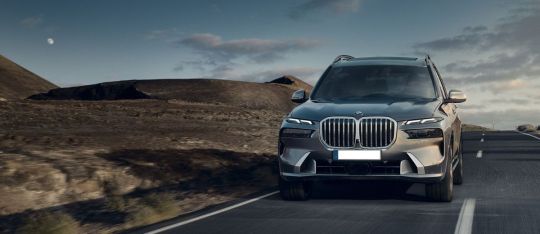
2025 BMW X7 Trim Level Comparison
The 2025 BMW X7 epitomises luxury and performance in the full-size SUV segment. BMW Canada offers this flagship model in two distinct trim levels: the xDrive40i and the M60i. Each trim is meticulously designed to cater to diverse driving preferences, blending opulence with cutting-edge technology.
BMW X7 xDrive40i

The xDrive40i serves as the entry point into the X7 lineup, yet it is anything but basic. Under the hood lies a robust 3.0-liter BMW TwinPower Turbo inline 6-cylinder engine, delivering a harmonious balance of power and efficiency. This engine ensures a dynamic driving experience, whether navigating urban landscapes or embarking on long-distance journeys.
Inside, the xDrive40i boasts a spacious cabin adorned with premium materials and finishes. The BMW Curved Display seamlessly integrates the instrument cluster and infotainment system, offering an intuitive interface for drivers. Ambient lighting and the innovative Light Bar beneath the decorative trim enhance the cabin's modern aesthetic. With seating for up to seven passengers and a generous cargo capacity of 750 litres with five occupants, the xDrive40i is tailored for both family adventures and executive travel.
BMW X7 M60i

For those seeking heightened performance, the M60i stands as a compelling choice. This trim is equipped with a formidable 4.4-liter BMW M TwinPower Turbo V8 engine, delivering exhilarating acceleration and power. The M60i's performance credentials are further accentuated by M-specific design elements and enhanced driving dynamics, ensuring a spirited ride that enthusiasts will appreciate.
The interior of the M60i mirrors its athletic exterior. Exclusive features such as the optional BMW Individual Full Merino upholstery in Bicolour Ivory White and Atlas Grey elevate the sense of luxury. Technological advancements, including the BMW Operating System 8.5, provide seamless connectivity and control. Additionally, the optional Bowers & Wilkins Diamond surround sound system offers an immersive audio experience, transforming every drive into a concert-like journey.
Shared Features and Options
Both trims come equipped with a suite of standard and optional features designed to enhance comfort, convenience, and safety. The optional Sky Lounge Panoramic Glass Sunroof bathes the cabin in natural light, creating an airy and open atmosphere. For climate control, the available automatic air conditioning with 5-zone control allows personalised temperature settings for all three rows, ensuring optimal comfort for every passenger.
In terms of driver assistance, the optional Driving Assistant Professional package offers a comprehensive suite of features, including adaptive cruise control and lane-keeping assistance, providing an extra layer of safety and convenience during long drives.
Frequently Asked Questions
What are the different trim levels available for the 2025 BMW X7? The 2025 BMW X7 is available in two trim levels:
xDrive40i: Equipped with a 3.0-litre BMW TwinPower Turbo inline 6-cylinder engine, offering a balance of power and efficiency.
M60i: Features a 4.4-litre BMW M TwinPower Turbo V8 engine, delivering enhanced performance and M-specific design elements.
Both trims come with BMW's xDrive all-wheel-drive system and a range of luxury and technology features.
What are the key engine and performance differences between the xDrive40i, M60i, and ALPINA XB7? The 2025 BMW X7 offers three engine options:
xDrive40i – 3.0L Turbo Inline-6 (375 hp, 398 lb-ft, 0-100 km/h in ~5.8s)
M60i – 4.4L Turbo V8 (523 hp, 553 lb-ft, 0-100 km/h in ~4.3s)
ALPINA XB7 – ALPINA-tuned 4.4L Bi-Turbo V8 (631 hp, 590 lb-ft, 0-100 km/h in ~4.2s)
All models feature xDrive AWD and an 8-speed automatic transmission.
What specific performance enhancements are included in the 2025 X7 M60i? The 2025 BMW X7 M60i includes several performance enhancements:
M TwinPower Turbo V8 Engine: Delivers 523 hp and accelerates from 0 to 100 km/h in 4.7 seconds.
8-speed Steptronic Sport Transmission: Ensures quick and smooth gear changes.
M-specific 2-axle Air Suspension: Provides adaptive ride comfort and enhanced handling.
These features combine to offer a dynamic and responsive driving experience.
What are the standard safety features included in all 2025 BMW X7 trim levels? The 2025 BMW X7 includes standard safety features across all trims, such as:
Active Protection System: Detects signs of driver fatigue, pretensions safety belts, adjusts seats to upright positions and closes windows and the sunroof in critical situations.
Adaptive Cruise Control: Maintains a set speed and distance from the vehicle ahead, adjusting as necessary.
Lane Keeping Assistant: Alerts the driver and provides steering inputs to prevent unintentional lane departures.
BMW Head-Up Display: Projects critical driving information onto the windshield for enhanced focus.
Where can I find a 2025 BMW X7 for sale, and how can I schedule a test drive? Visit Windsor BMW at 9425 Tecumseh Rd E, Windsor, ON, to see the 2025 BMW X7 and book a test drive. Call ahead for availability.
Conclusion
The 2025 BMW X7, in both xDrive40i and M60i trims, exemplifies BMW's commitment to luxury, performance, and innovation. Whether prioritising refined comfort or dynamic driving capabilities, the X7 offers a tailored experience to meet the discerning tastes of Canadian drivers. Meet our expert team at Overseas BMW to get information on the BMW X7 price and BMW X7 for sale. Overseas BMW is one of your trusted BMW dealerships near me.
1 note
·
View note
Text
Mazda Slashes $3.3B From EV Plans, Confirms Hybrid SkyActiv-Z Engine For New CX-5 | Carscoops
0 notes